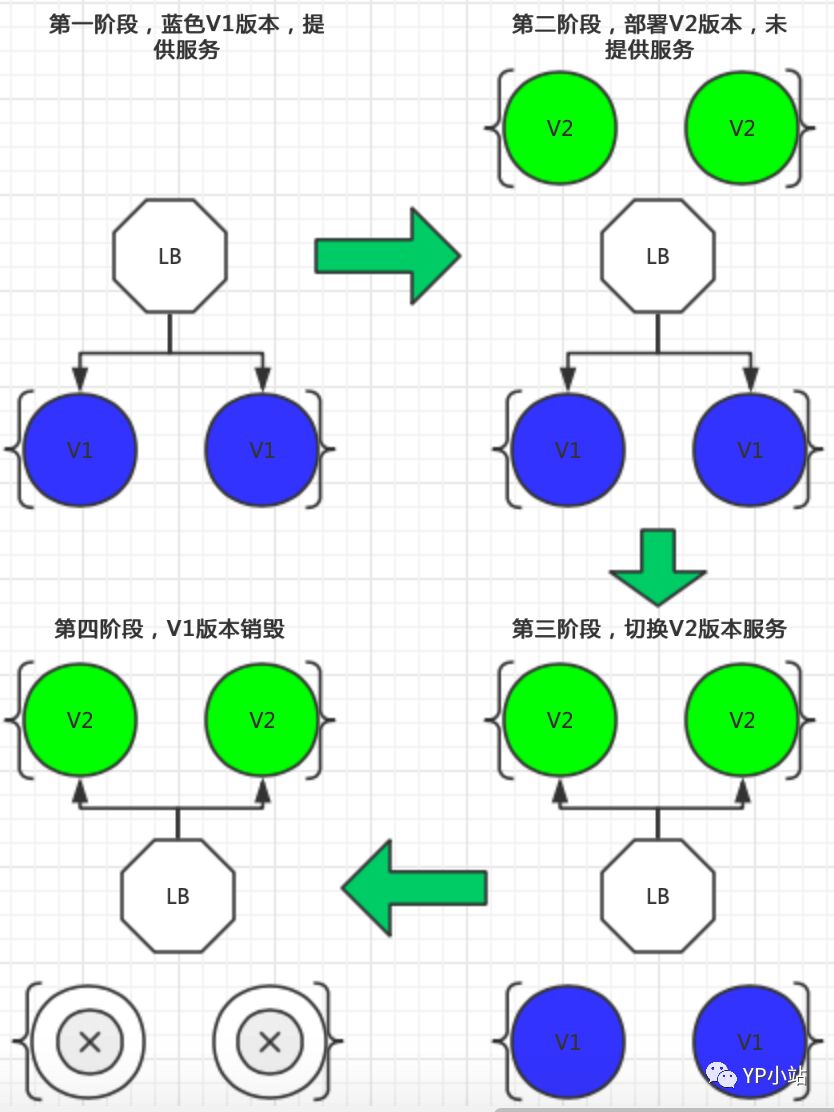Table of Contents
[TOC]
蓝绿部署
什么是蓝绿部署
蓝绿(blue/green):新版本与旧版本一起存在,然后切换流量
蓝绿部署流程图

K8S中如何实现蓝绿部署
- 通过k8s service label标签来实现蓝绿发布
- 通过Ingress 控制器来实现蓝绿发布
- 通过Istio来实现蓝绿发布,或者像Istio类似的服务
k8s 蓝绿 yaml 配置
service.yaml 文件
apiVersion: v1
kind: Service
metadata:
name: demo
namespace: default
labels:
app: demo
spec:
ports:
- port: 80
targetPort: http
protocol: TCP
name: http
# 注意这里我们匹配 app 和 version 标签,当要切换流量的时候,我们更新 version 标签的值,比如:v2
selector:
app: demo
version: v1
蓝 v1-deploy.yaml 文件
apiVersion: apps/v1
kind: Deployment
metadata:
name: demo1-deployment
namespace: default
labels:
app: demo
version: v1
spec:
replicas: 1
revisionHistoryLimit: 3
strategy:
rollingUpdate:
maxSurge: 30%
maxUnavailable: 30%
selector:
matchLabels:
app: demo
version: v1
template:
metadata:
labels:
app: demo
version: v1
spec:
containers:
- name: demo1
image: mritd/demo
livenessProbe:
httpGet:
path: /
port: 80
scheme: HTTP
initialDelaySeconds: 30
timeoutSeconds: 5
periodSeconds: 30
successThreshold: 1
failureThreshold: 5
readinessProbe:
httpGet:
path: /
port: 80
scheme: HTTP
initialDelaySeconds: 30
timeoutSeconds: 5
periodSeconds: 10
successThreshold: 1
failureThreshold: 5
ports:
- name: http
containerPort: 80
protocol: TCP
绿 v2-deploy.yaml
apiVersion: apps/v1
kind: Deployment
metadata:
name: demo2-deployment
namespace: default
labels:
app: demo
version: v2
spec:
replicas: 1
revisionHistoryLimit: 3
strategy:
rollingUpdate:
maxSurge: 30%
maxUnavailable: 30%
selector:
matchLabels:
app: demo
version: v2
template:
metadata:
labels:
app: demo
version: v2
spec:
containers:
- name: demo2
image: mritd/demo
livenessProbe:
httpGet:
path: /
port: 80
scheme: HTTP
initialDelaySeconds: 30
timeoutSeconds: 5
periodSeconds: 30
successThreshold: 1
failureThreshold: 5
readinessProbe:
httpGet:
path: /
port: 80
scheme: HTTP
initialDelaySeconds: 30
timeoutSeconds: 5
periodSeconds: 10
successThreshold: 1
failureThreshold: 5
ports:
- name: http
containerPort: 80
protocol: TCP
上面定义的资源对象中,最重要的就是Service 中 label selector的定义:
selector:
app: demo
version: v1
部署与测试
部署v1 v2 deploy服务 和 service服务
$ kubectl apply -f service.yaml -f v1-deploy.yaml -f v2-deploy.yaml
测试流量是否到v1版本
# 登陆任意一个pod,向 demo service 发起请求
$ while sleep 0.3; do curl http://demo; done
# 输出日志
Host: demo1-deployment-b5bd596d8-dw27b, Version: v1
Host: demo1-deployment-b5bd596d8-dw27b, Version: v1
切换入口流量从v1 到 v2
$ kubectl patch service demo -p '{"spec":{"selector":{"version":"v2"}}}'
测试流量是否到v2版本
# 登陆任意一个pod,向 demo service 发起请求
$ while sleep 0.3; do curl http://demo; done
# 输出日志
Host: demo2-deployment-b5bd596d8-dw27b, Version: v2
Host: demo2-deployment-b5bd596d8-dw27b, Version: v2
金丝雀
什么是金丝雀发布?
金丝雀发布(Canary):也是一种发布策略,和国内常说的灰度发布是同一类策略。蓝绿部署是准备两套系统,在两套系统之间进行切换,金丝雀策略是只有一套系统,逐渐替换这套系统。
Istio 金丝雀部署
定义 service 服务
apiVersion: v1
kind: Service
metadata:
name: demo4
namespace: test1
labels:
app: demo4
spec:
ports:
- port: 80
targetPort: http
protocol: TCP
name: http
selector:
app: demo4
定义两个版本的 deploy 文件,两个版本都包含服务选择标签 app:demo4
apiVersion: apps/v1beta1
kind: Deployment
metadata:
name: demo4-deployment-v1
namespace: test1
spec:
replicas: 1
template:
metadata:
annotations:
# 允许注入 sidecar
sidecar.istio.io/inject: "true"
labels:
app: demo4
version: v1
spec:
containers:
- name: demo4-v1
image: mritd/demo
livenessProbe:
httpGet:
path: /
port: 80
scheme: HTTP
initialDelaySeconds: 30
timeoutSeconds: 5
periodSeconds: 10
successThreshold: 1
failureThreshold: 5
readinessProbe:
httpGet:
path: /
port: 80
scheme: HTTP
initialDelaySeconds: 30
timeoutSeconds: 5
periodSeconds: 10
successThreshold: 1
failureThreshold: 5
ports:
- name: http
containerPort: 80
protocol: TCP
---
apiVersion: apps/v1beta1
kind: Deployment
metadata:
name: demo4-deployment-v2
namespace: test1
spec:
replicas: 1
template:
metadata:
labels:
app: demo4
version: v2
annotations:
sidecar.istio.io/inject: "true"
spec:
containers:
- name: demo4-v2
image: mritd/demo
livenessProbe:
httpGet:
path: /
port: 80
scheme: HTTP
initialDelaySeconds: 30
timeoutSeconds: 5
periodSeconds: 10
successThreshold: 1
failureThreshold: 5
readinessProbe:
httpGet:
path: /
port: 80
scheme: HTTP
initialDelaySeconds: 30
timeoutSeconds: 5
periodSeconds: 10
successThreshold: 1
failureThreshold: 5
ports:
- name: http
containerPort: 80
protocol: TCP
上面定义和普通k8s定义蓝绿部署是一样的
设置路由规则来控制流量分配。如将 10% 的流量发送到金丝雀版本(v2)。后面可以渐渐的把所有流量都切到金丝雀版本(v2),只需要修改weight: 10参数,注意v1和v2版本和一定要等于100
apiVersion: networking.istio.io/v1alpha3
kind: VirtualService
metadata:
name: demo4-vs
namespace: test1
spec:
hosts:
- demo4.a.com
gateways:
- demo4-gateway
http:
- route:
- destination:
host: demo4.test1.svc.cluster.local
subset: v1
weight: 90
- destination:
host: demo4.test1.svc.cluster.local
subset: v2
weight: 10
---
apiVersion: networking.istio.io/v1alpha3
kind: DestinationRule
metadata:
name: demo4
namespace: test1
spec:
host: demo4.test1.svc.cluster.local
subsets:
- name: v1
labels:
version: v1
- name: v2
labels:
version: v2
当规则设置生效后,Istio 将确保只有 10% 的请求发送到金丝雀版本,无论每个版本的运行副本数量是多少。
高层次的金丝雀部署
只允许特定网站上50%的用户流量路由到金丝雀(v2)版本,而其他用户则不受影响
apiVersion: networking.istio.io/v1alpha3
kind: VirtualService
metadata:
name: demo4-vs
namespace: test1
spec:
hosts:
- demo4.a.com
gateways:
- demo4-gateway
http:
- match:
- headers:
cookie:
regex: "^(.*?;)?(email=[^;]*@some-company-name.com)(;.*)?$"
route:
- destination:
host: demo4.test1.svc.cluster.local
subset: v1
weight: 50
- destination:
host: demo4.test1.svc.cluster.local
subset: v2
weight: 50
- route:
- destination:
host: demo4.test1.svc.cluster.local
subset: v1
VirtualService 与 DestinationRule 解释
- Istio Virtual Service,用于控制当前deployment和金丝雀deployment流量分配的权重
- Istio Destination Rule,包含当前deployment和金丝雀deployment的子集(subset)
- Istio Gateway(可选),如果服务需要从容器集群外被访问则需要搭建gateway
参考
https://archive.istio.io/v1.2/zh/docs/tasks/traffic-management/request-routing/
https://archive.istio.io/v1.2/zh/blog/2017/0.1-canary/